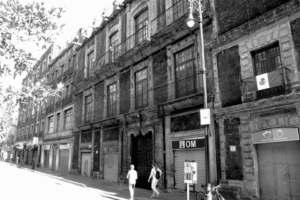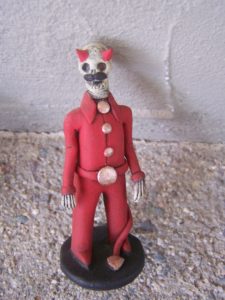Podcast: Play in new window | Download
Subscribe: Apple Podcasts | RSS
Mexico City is the capital city and largest city in Mexico. In fact, it is one of the largest cities in the world. It’s hard to make a tally, but the greater Mexico City metropolitan area may contain upwards of twenty-five million people. The Aztecs founded the city of Tenochtitlan on the site of modern-day Mexico City in 1324 and made it the capital of their empire. Before the Aztecs, other indigenous groups lived in small communities in the Basin of Mexico on which the modern super city now stands. Because of such long, uninterrupted human habitation, the area has a lot of history. Along with the history come many legends. Here are four.
The Lovelorn Nun
In colonial Mexico City, sometime in the late 16th Century, there lived a young and beautiful woman named María de Ávila. She was the youngest of 3 siblings, having two older brothers, Alonzo and Gil. María enjoyed a life of wealth and comfort. Her father and grandfather had amassed a considerable fortune in the galleon trade importing luxury good from the Spanish Philippines and other parts of the Orient. Alonzo and Gil would inherit the family fortune and business enterprises while María would marry well. Those were the expectations from society of a notable family in 16th Century New Spain. María’s heart had other plans, however. The beautiful young woman fell in love with a mestizo man named Arrutia who eventually wanted to marry her. María’s brothers, of course, did not approve of this man who had no station in life and whose origins were unknown and unknowable. Alonzo and Gil moved swiftly to end the romance quietly and paid  Arrutia to leave Mexico City. The man left and since María had no knowledge of these plans to end her romance, she spent days in the palatial home of the family pining away for her lost love. The Ávila brothers knew that the low-born Arrutia would eventually come back to the city, so they forced María to join a convent near the family home. The convent, attached to the Templo de la Concepción, was part of one of the oldest churches in Mexico City, built in 1540, and still stands to this day. María entered the convent reluctantly and went about the tasks of a novice, until one day her love did return and soon found out what happened to her. Eventually, Arrutia showed up at the convent and wanted to take his beautiful love away with him to another part of New Spain. The Mother Superior at the convent found out about María’s secret rendezvous with her paramour and made the decision to cloister her. María was to receive no visitors, not even members of her family. The young nun did not take too kindly to her restrictions and one night she found a long rope and decided to take her life into her own hands. She went into the courtyard of the nunnery and strung the rope along one of the top branches of a sturdy peach tree. In the darkness of the night, María ended her own life by hanging. A young novice discovered her body the next day. Days later another young nun was looking into the waters of a fountain in the same courtyard and saw the image of María. Other sisters began seeing María’s image in ghostly form in other parts of the convent, too. The Mother Superior put the nunnery on a sort of lockdown until the ghostly sightings of the young broken-hearted nun subsided. No sister was allowed out of her cell after dark and no one was to be alone at any time of the day. María’s love interest, the young Arrutia, heard about María’s untimely death about a week after it happened and went to the convent immediately. While in front of the building, he saw an image of María appear on a wall and unable to bear what he had seen, he dropped dead of a heart attack. After the death of Arrutia the nuns never saw the ghost of María again, but in later years María seemed to reappear off and on scaring churchgoers, clergy and neighbors, with even some sightings taking place well into the 21st Century.
Arrutia to leave Mexico City. The man left and since María had no knowledge of these plans to end her romance, she spent days in the palatial home of the family pining away for her lost love. The Ávila brothers knew that the low-born Arrutia would eventually come back to the city, so they forced María to join a convent near the family home. The convent, attached to the Templo de la Concepción, was part of one of the oldest churches in Mexico City, built in 1540, and still stands to this day. María entered the convent reluctantly and went about the tasks of a novice, until one day her love did return and soon found out what happened to her. Eventually, Arrutia showed up at the convent and wanted to take his beautiful love away with him to another part of New Spain. The Mother Superior at the convent found out about María’s secret rendezvous with her paramour and made the decision to cloister her. María was to receive no visitors, not even members of her family. The young nun did not take too kindly to her restrictions and one night she found a long rope and decided to take her life into her own hands. She went into the courtyard of the nunnery and strung the rope along one of the top branches of a sturdy peach tree. In the darkness of the night, María ended her own life by hanging. A young novice discovered her body the next day. Days later another young nun was looking into the waters of a fountain in the same courtyard and saw the image of María. Other sisters began seeing María’s image in ghostly form in other parts of the convent, too. The Mother Superior put the nunnery on a sort of lockdown until the ghostly sightings of the young broken-hearted nun subsided. No sister was allowed out of her cell after dark and no one was to be alone at any time of the day. María’s love interest, the young Arrutia, heard about María’s untimely death about a week after it happened and went to the convent immediately. While in front of the building, he saw an image of María appear on a wall and unable to bear what he had seen, he dropped dead of a heart attack. After the death of Arrutia the nuns never saw the ghost of María again, but in later years María seemed to reappear off and on scaring churchgoers, clergy and neighbors, with even some sightings taking place well into the 21st Century.
Don Juan Manuel and the Devil
 As a young man from the minor nobility of Spain, Don Juan Manuel de Solórzano left his homeland and arrived in Mexico City in 1612. He soon became the right-hand man of the viceroy and used his influence in government to start and grow prosperous businesses in Mexico. Don Juan Manuel further enhanced his own prestige by marrying the beautiful, young Marina Laguna, a daughter of a wealthy silver miner from Zacatecas. Juan Manuel and Marina had a great life and were the talk of Mexico City society. The couple seemed to have it all except for one thing: They could not have children. Juan Manuel wanted a family desperately. He made the decision to go on a retreat to the Monastery of San Francisco to make himself right with God and do whatever penance was necessary to ensure the continuation of his family line. In preparation for his time away, he called on his capable teenage nephew to come to Mexico City from Spain to run his businesses and take care of his affairs in his absence. As soon as the boy arrived, Juan Manuel went to the monastery to do what he needed to do. He did not spend his time at San Francisco completely cut off from the outside world, however. Within a few weeks, Don Juan Manuel had heard rumors that his wife was enjoying the company of another man. This drove him crazy with
As a young man from the minor nobility of Spain, Don Juan Manuel de Solórzano left his homeland and arrived in Mexico City in 1612. He soon became the right-hand man of the viceroy and used his influence in government to start and grow prosperous businesses in Mexico. Don Juan Manuel further enhanced his own prestige by marrying the beautiful, young Marina Laguna, a daughter of a wealthy silver miner from Zacatecas. Juan Manuel and Marina had a great life and were the talk of Mexico City society. The couple seemed to have it all except for one thing: They could not have children. Juan Manuel wanted a family desperately. He made the decision to go on a retreat to the Monastery of San Francisco to make himself right with God and do whatever penance was necessary to ensure the continuation of his family line. In preparation for his time away, he called on his capable teenage nephew to come to Mexico City from Spain to run his businesses and take care of his affairs in his absence. As soon as the boy arrived, Juan Manuel went to the monastery to do what he needed to do. He did not spend his time at San Francisco completely cut off from the outside world, however. Within a few weeks, Don Juan Manuel had heard rumors that his wife was enjoying the company of another man. This drove him crazy with  jealousy and rage. He left the monastery to seek revenge. Because Juan Manuel did not know who was responsible for ruining his marriage, he enlisted the help of a sorceress who was well recommended. The woman was a mulata with large gold earrings and a red turban and she was well versed in ancient African magic taught to her by her grandmother who was brought to Mexico as a slave. The solution of the sorceress was to conjure up Satan himself to help Juan Manuel with his dilemma. With some chants in a language unknown to this high-born man, the woman fulfilled her promise and in a puff of smoke, the Devil appeared. He gave instructions to the vengeful man: Juan Manuel was to wait outside his house on Uruguay Street and he was to stab the first man walking by after the stroke of 11 o’clock. So, the next night, Juan Manuel waited, and lurched out of the shadows after the clock struck eleven to kill the first man he saw, stabbing him with his knife. Immediately after the murder the Devil again appeared to Juan Manuel and told him that he had killed the wrong man. Juan Manuel protested and insisted he had followed the Devil’s instructions to the letter. The Devil then told him to try again the next evening: The first man passing by his house at the stroke of 11 was to be stabbed to death because this man was the one who had defiled his marriage. The next night Juan Manuel repeated the deed, but this time the man he stabbed was his own teenage nephew. The Devil appeared again and told him to try again the following night. So distraught and struck with grief and remorse, Juan Manuel fled to the Monastery of San Francisco to ask one of the monks for forgiveness and to give him his penance. The monk told him to go to the gallows and spend three days and nights praying the rosary and that would absolve him of his mortal sins. Juan Manuel took the counsel of his religious advisor and went to the gallows to do his penance. On the third day of prayer and contrition, a group of angry angels appeared. The angels grabbed Juan Manuel and hoisted him up on the gallows, making him pay the ultimate price for taking those lives and for making a pact with the Devil. The ghost of Don Juan Manuel is said to haunt the neighborhood around Uruguay Street to this day.
jealousy and rage. He left the monastery to seek revenge. Because Juan Manuel did not know who was responsible for ruining his marriage, he enlisted the help of a sorceress who was well recommended. The woman was a mulata with large gold earrings and a red turban and she was well versed in ancient African magic taught to her by her grandmother who was brought to Mexico as a slave. The solution of the sorceress was to conjure up Satan himself to help Juan Manuel with his dilemma. With some chants in a language unknown to this high-born man, the woman fulfilled her promise and in a puff of smoke, the Devil appeared. He gave instructions to the vengeful man: Juan Manuel was to wait outside his house on Uruguay Street and he was to stab the first man walking by after the stroke of 11 o’clock. So, the next night, Juan Manuel waited, and lurched out of the shadows after the clock struck eleven to kill the first man he saw, stabbing him with his knife. Immediately after the murder the Devil again appeared to Juan Manuel and told him that he had killed the wrong man. Juan Manuel protested and insisted he had followed the Devil’s instructions to the letter. The Devil then told him to try again the next evening: The first man passing by his house at the stroke of 11 was to be stabbed to death because this man was the one who had defiled his marriage. The next night Juan Manuel repeated the deed, but this time the man he stabbed was his own teenage nephew. The Devil appeared again and told him to try again the following night. So distraught and struck with grief and remorse, Juan Manuel fled to the Monastery of San Francisco to ask one of the monks for forgiveness and to give him his penance. The monk told him to go to the gallows and spend three days and nights praying the rosary and that would absolve him of his mortal sins. Juan Manuel took the counsel of his religious advisor and went to the gallows to do his penance. On the third day of prayer and contrition, a group of angry angels appeared. The angels grabbed Juan Manuel and hoisted him up on the gallows, making him pay the ultimate price for taking those lives and for making a pact with the Devil. The ghost of Don Juan Manuel is said to haunt the neighborhood around Uruguay Street to this day.
The Ghostly Girl Who Stops Traffic
 In the late 1990s in the Colonia del Valle Centro neighborhood of Mexico City, a story began to circulate about the tragic death of a local 9-year-old girl who left her home at 2:00 am to go to the pharmacy to buy medicine for her sick mother. The girl went off to the pharmacy alone. At the corner of Eugenia and Calle Gabriel Mancera the little girl waited for the light to turn red so she could cross safely. While she was in the middle of the crosswalk, a car blew through the red light at a very high velocity and hit the girl head-on. The driver of the car did not stop to offer her any assistance. The little girl lay there on the pavement, struggling to hold onto life, in extreme pain, and no one would come to her, even though she cried out for help. At dawn, someone discovered the body of the little girl on their way to work and news of the tragedy soon spread throughout the neighborhood. According to many eyewitnesses, the girl appears in ghostly form near this same intersection at the approximate time of her death to try to slow down cars. In some stories, her spirit is an angry one and wants to cause accidents to those vehicles flying through the intersection at unsafe speeds. In one account, the ghost of the livid little girl was seen pointing her finger maliciously at a speeding car causing one of its front tires to blow out. Many people believe that she wants to take revenge not just on speeders but on the whole neighborhood for leaving her there after the accident to die alone in the dark. Even twenty years later people in the Valle Centro neighborhood think twice about going out late at night near the intersection of Eugenia and Gabriel Mancena. No one wants to cross paths with the angry ghostly girl.
In the late 1990s in the Colonia del Valle Centro neighborhood of Mexico City, a story began to circulate about the tragic death of a local 9-year-old girl who left her home at 2:00 am to go to the pharmacy to buy medicine for her sick mother. The girl went off to the pharmacy alone. At the corner of Eugenia and Calle Gabriel Mancera the little girl waited for the light to turn red so she could cross safely. While she was in the middle of the crosswalk, a car blew through the red light at a very high velocity and hit the girl head-on. The driver of the car did not stop to offer her any assistance. The little girl lay there on the pavement, struggling to hold onto life, in extreme pain, and no one would come to her, even though she cried out for help. At dawn, someone discovered the body of the little girl on their way to work and news of the tragedy soon spread throughout the neighborhood. According to many eyewitnesses, the girl appears in ghostly form near this same intersection at the approximate time of her death to try to slow down cars. In some stories, her spirit is an angry one and wants to cause accidents to those vehicles flying through the intersection at unsafe speeds. In one account, the ghost of the livid little girl was seen pointing her finger maliciously at a speeding car causing one of its front tires to blow out. Many people believe that she wants to take revenge not just on speeders but on the whole neighborhood for leaving her there after the accident to die alone in the dark. Even twenty years later people in the Valle Centro neighborhood think twice about going out late at night near the intersection of Eugenia and Gabriel Mancena. No one wants to cross paths with the angry ghostly girl.
The Witch of Coyoacán
In colonial times, Coyoacán was its own separate town, but it has long since been gobbled up by the Mexico City megalopolis and is now considered a part of the city. In the late 1700s, a man named Miguel, said to be the most handsome man in all Coyoacán, married a beautiful young woman who was barely out of her teens. They settled down and wanted to start a family. One day, Miguel’s friend started asking questions about his wife. Miguel told his friend that all was well on the domestic front and in addition to being very beautiful and attentive, his wife was an excellent cook. Her specialty dish was moronga, a type of blood sausage that originally came from the Spanish parts of the Caribbean. Miguel’s friend looked at him cautiously and told him that it was a bad thing to eat moronga because one could never be too sure about the ingredients. Besides that, it just wasn’t healthy. The friend suggested to Miguel that he ask his wife why she always prepares this dish. So, the next day Miguel did ask his wife and she told him that her family always prepared it and it was a healthy dish because it cured many different ailments and it was good for the soul. Miguel returned to his friend to tell him of his wife’s explanation. The friend apologized, and explained that it was not his place to gossip, but there was talk around Coyoacán that his wife was really a witch and was going around at night killing people and using them to make the moronga. While Miguel had a hard time believing this, he couldn’t stop thinking about it. His wife  would always get up early, sometimes hours before the sun rose to start preparing the food for the day and to get a head start on other chores. Miguel was never awake when his wife got up, but the day after his friend put in his head the idea that his wife could be a witch, Miguel woke up early and spied on his wife. What he saw astonished him. In the kitchen of their home, the woman shed her own skin and turned into an orb of light, and then floated out the window, heading for the village. Miguel ran to the house of his friend to tell him what happened. The friend returned with Miguel to Miguel’s house and they both saw the skin of the woman on the floor. Miguel’s friend had an idea: They would burn the skin so that the witch could not return to human form. They threw the skin into the furnace. When the sun started to come up, the witch returned to the house with fresh ingredients for the day’s moronga but was unable to find her human skin which she left on the kitchen floor. As the dawn broke and the first rays of light hit their house, the bright orb of light that was the witch began to change colors and then dissolve. So ended the life of the Witch of Coyoacán.
would always get up early, sometimes hours before the sun rose to start preparing the food for the day and to get a head start on other chores. Miguel was never awake when his wife got up, but the day after his friend put in his head the idea that his wife could be a witch, Miguel woke up early and spied on his wife. What he saw astonished him. In the kitchen of their home, the woman shed her own skin and turned into an orb of light, and then floated out the window, heading for the village. Miguel ran to the house of his friend to tell him what happened. The friend returned with Miguel to Miguel’s house and they both saw the skin of the woman on the floor. Miguel’s friend had an idea: They would burn the skin so that the witch could not return to human form. They threw the skin into the furnace. When the sun started to come up, the witch returned to the house with fresh ingredients for the day’s moronga but was unable to find her human skin which she left on the kitchen floor. As the dawn broke and the first rays of light hit their house, the bright orb of light that was the witch began to change colors and then dissolve. So ended the life of the Witch of Coyoacán.
The largest city in Mexico is full of many mysteries, miracles and lots of magic. With such a large population in the same area for many centuries, many legends exist, stories that serve as lessons or simply get repeated for entertainment. Are some of those stories based on facts? That’s for the listener to decide.
REFERENCES
Mas por Mas web site
Leyendas de Mexico web site
